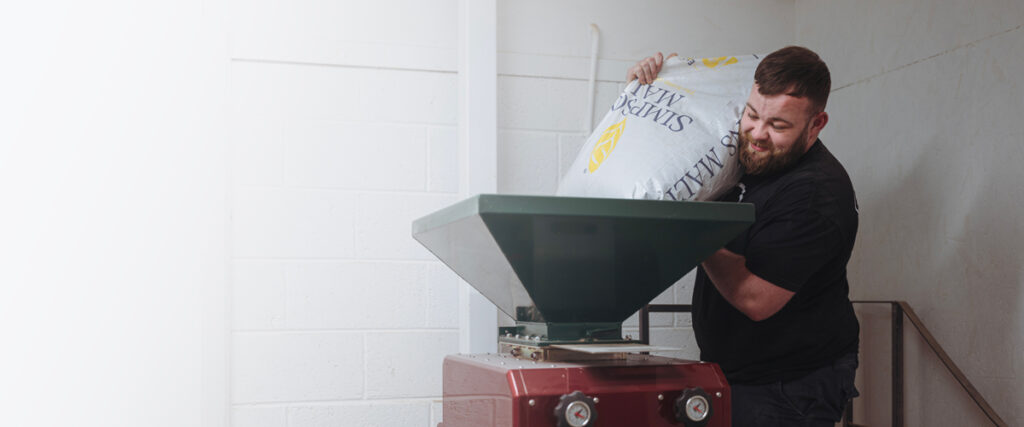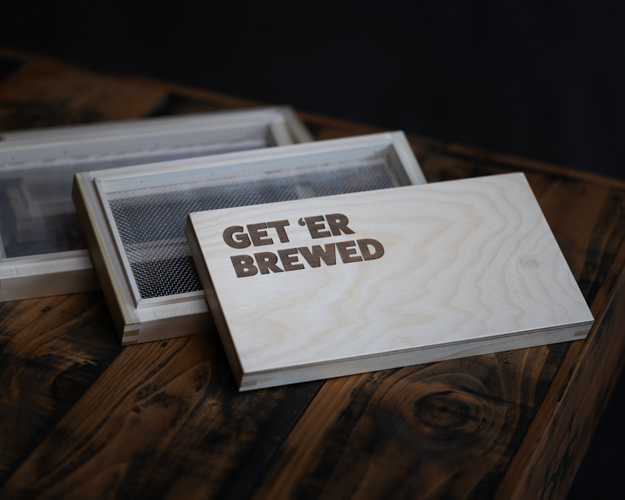This is obviously tricky since everybody’s brewhouse is different…and, therefore, needs a different crush. Still, one thing we take pride in here at GEB is ensuring that we are consistently crushing the malts we sell to a high spec, ensuring the perfect balance between runoff and efficiency. How to crush malt correctly is something we take pride in. We regularly get complimented on the quality of the malts we sell crushed compared to competitors as we keep a close eye on this in-house here and have designed our very own GEB 3 Tier Grist Shaker Box for monitoring the crush.

Things to keep in mind when crushing malt:
- Grind Consistency: Leaving the husk as intact as possible. Milling Gap adjustment and how to vary the gap depending on the type of malt.
- Avoid over-crushing: Excessive amounts of flour can cause a stuck mash and poor wort separation & can also lead to increased tannin extraction from the husks, resulting in astringent flavours in the beer.
- Conditioning the malt: Adding water in specific setups before crushing can help soften the husks, protecting them during milling.
- Regular maintenance: Inspect and maintain your mill to ensure the rollers aren’t worn.
- Use fresh malt: Use malt that’s been stored correctly. In other words, buy from reputable suppliers who manage stock and store it in the best conditions.
- Malt Type Considerations: Always adjust the mill gap based on the type of malt instead of the setting for a recipe, as all malts crush differently.
- Uniform feed rate: Always feed the malt into the mill at a consistent rate to prevent clogging or jamming. Dust control is essential for health and fire safety.
- Testing and Adjusting: Using the GEB grist analysis shaker box when you change malt supply or when new season malt starts to become available
But the short answer on how to crush malt correctly is:
Infusion Brewers need a balance of:
- Not to over-crushing their malt, which has a particular risk of causing slow run-offs (or even stuck mashes).
- Equally, not to under crush since this won’t efficiently yield sugar from exposed starch in the grain. This would mean less volume of Beer can be made!
Therefore, Brewers need to monitor crush levels regularly. Part of this is because Barley, like all natural materials, is subject to climate, season and variety. This means that the kernel size of the grain will vary each year and may be easier to crush (known as friability) depending on malting conditions. Both these things will influence the final grist composition. The best way to account for this and ensure that you are brewing most efficiently is to check the crush going through your mill regularly.
For this, we recommend a simple 3-tier Grist Box, which will tell you if you’re getting the most out of your malt.


As a guide:
Geterbrewed takes a sample from our mill, and weighs out a 100g representative sample, and places it into our Grist Analysis Shaker Box. We have had these made specifically to our needs by a local furniture maker. We added screens that allow us to help you crush your malts correctly. When taking the sample, you need to remember the protocol you use from one sample to another to eliminate variables affecting the reading. At GEB, we keep the variables the same where possible. always Using the 3-tier GEB grist box, always using 100g as a sample. Always timing the shaker box movement to 60 seconds, and always moving between two marked lines on the wall at a consistent rate.
- If the top sieve (anything over 1.98mm) is more than 50% – try tightening your rollers. There may be extra sugar in there going to waste!
- Do this in increments of 0.1mm, seeing how it changes the crush each time.
- For a standard two roller Mill, we recommend a 1.55mm roller gap as a start setting.
- The base (anything under 0.212mm sieve) should be no more than 10%. Otherwise, you risk slow run-offs on an infusion mash tun.
- Simply widen the roller gap by 0.1mm at a time, assessing until you see an improvement.
Take note:
It is worth mentioning that some malts will behave very differently in the mill. For example Oat Malt is very different to Barley. It has a long, thin kernel, that can easily slip through the rollers used for Barley. Rye is another product that will require different settings. We therefore recommend 1.3mm be used as a base setting for Oat Malt, else your NEIPA’s may have dramatically extract reduced yields.
If you have an issue with your mill you can buy crushed malt from ourselves & we also sell Rice Hulls if you need to add some extra filterability with some steam cleaned rice hulls. If you want to learn more about how to crush malt correctly checkout the video we made on youtube: